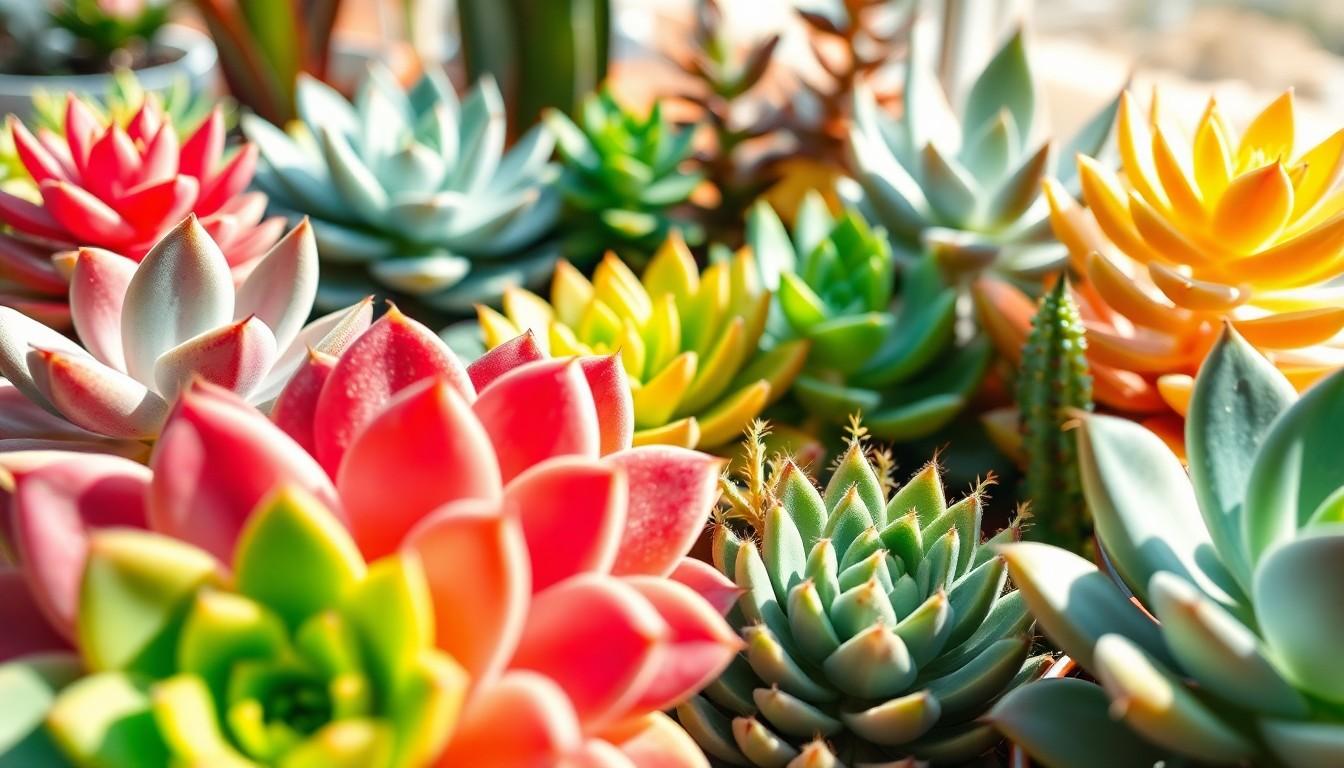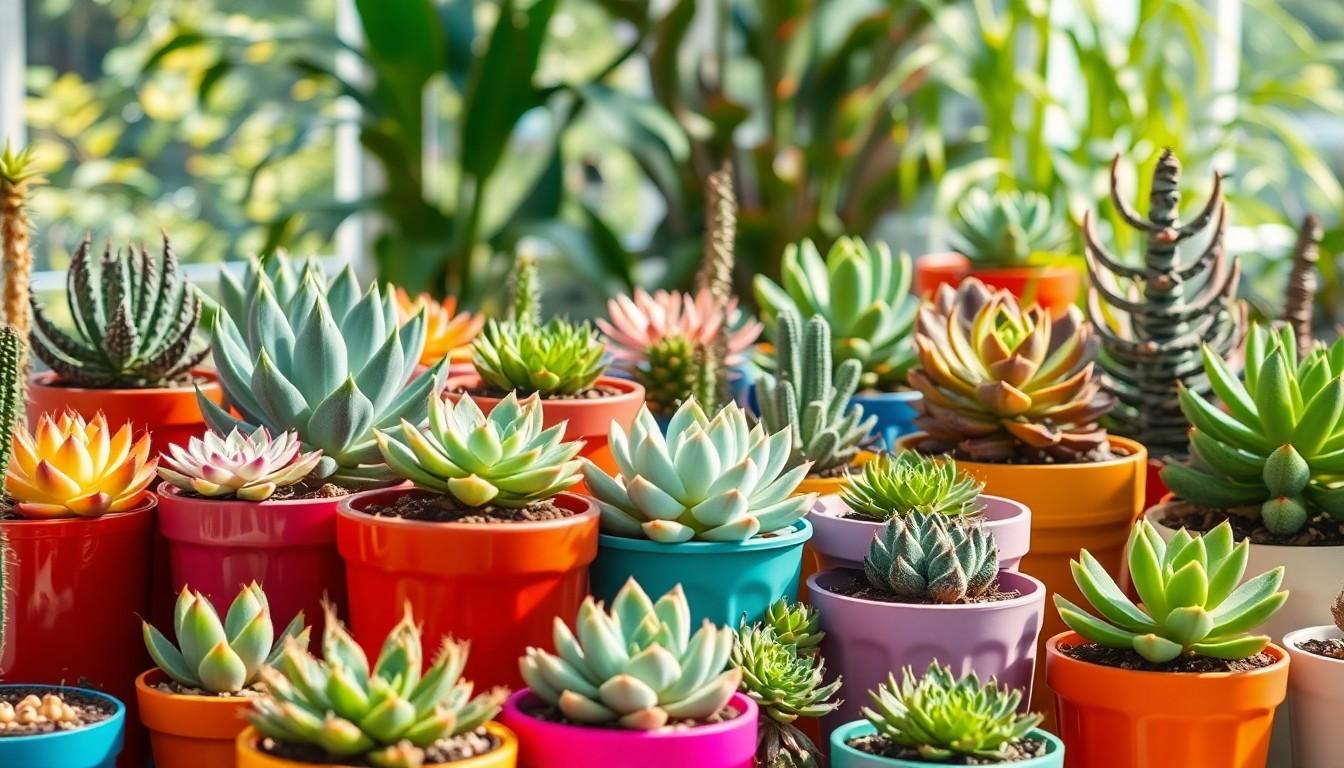Succulents have taken the plant world by storm, and for good reason. These charming little green wonders are like the superheroes of the botanical realm. They’re low-maintenance, stylish, and can survive a drought better than most of us can survive a Monday morning. With a variety of shapes, sizes, and colors, succulents can transform any space into a mini oasis.
Overview of Popular Types of Succulents
Succulents encompass a wide range of species, each with unique characteristics. Some of the most sought-after varieties include Aloe Vera, known for its medicinal properties. Additionally, Echeveria species attract attention with their rosette shapes and vibrant colors.
Jade Plant offers an appealing option due to its easy care and classic appearance. Varieties, such as Sedum, thrive in gardens and containers, providing beautiful ground cover. The striking Haworthia captivates with its textured leaves and low-maintenance requirements.
String of Pearls, a trailing succulent, adds elegance to any space with its distinctive bead-like leaves. A popular choice for indoor settings, Zebra Plant features white stripes on its leaves, enhancing visual interest.
Agave, often used in landscaping, boasts striking architectural forms that make a bold statement in gardens. Lithops, also known as living stones, blend seamlessly into rocky landscapes due to their natural camouflage.
Each succulent type comes with specific care requirements. Some, like Kalanchoe, produce vibrant flowers, while others focus on foliage. Light conditions, watering habits, and soil types contribute to their success as popular houseplants.
Understanding these varieties aids in successful cultivation, providing plant enthusiasts with options for diverse environments. Succulents continue to capture interest with their versatility and adaptability, allowing for a variety of displays in homes or offices.
Characteristics of Succulents

Succulents exhibit unique traits that contribute to their appeal. These plants store water in their leaves, stems, and roots, allowing them to thrive in arid conditions.
Water Storage Mechanisms
Water storage mechanisms differentiate succulents from other plants. Thick, fleshy leaves typically house reservoirs of moisture. Some varieties, like Aloe Vera, can retain large amounts of water, enabling them to survive long dry spells. Stems in certain succulents also serve as storage; for example, cacti utilize their stems for significant water retention. This ability to store water not only aids in survival but reduces the frequency of watering for plant caregivers.
Adaptations to Environment
Adaptations enhance succulents’ resistance to harsh climates. Many succulents feature waxy cuticles that minimize water loss from their surfaces. Their leaf shapes often reflect evolutionary responses to extreme sunlight conditions, promoting efficiency in photosynthesis while conserving moisture. Root systems also adapt; shallow roots capture rainfall quickly, while deeper roots seek moisture underground. These traits ensure succulents flourish in diverse environments, from deserts to indoor gardens.
Common Popular Types of Succulents
Succulents come in various types, each showcasing unique features and care requirements. Below are some popular types of succulents that enthusiasts often choose.
Echeveria
Echeveria boasts rosette-shaped leaves that form vibrant arrangements. Various colors range from deep greens to soft pastels, offering aesthetic appeal. These plants thrive in bright, indirect sunlight and prefer well-draining soil. Watering should be moderate, allowing the soil to dry out between sessions. Ideal temperatures for Echeveria fall between 65°F and 80°F. Pests may include mealybugs, so regular checks help maintain health.
Sedum
Sedum encompasses a large group of succulents, known for their hardy nature. These plants can tolerate a wide range of conditions, making them suitable for diverse gardens. The majority of Sedum types prefer full sun exposure and require minimal water. Varieties such as Stonecrop adapt well to rocky terrains, showcasing colors from green to vibrant red in the fall. Regular pruning encourages bushier growth while enhancing airflow.
Aloe Vera
Aloe Vera is well-known for its medicinal properties and striking appearance. The thick, fleshy leaves contain a gel-like substance valued for skin healing. Bright, indirect light fosters growth while preventing leaf burn. Allowing the soil to dry completely between waterings promotes healthy roots. This succulent thrives in temperatures between 60°F and 75°F, supporting its overall resilience. Avoid overwatering, as it can lead to root rot.
Haworthia
Haworthia features geometric rosettes with thick, fleshy leaves, making it a perfect choice for indoor settings. Varieties exhibit interesting patterns and colors, ranging from dark greens to striped forms. These plants prefer indirect sunlight, thriving in partially shaded environments. Soil quality should include a blend designed for succulents, ensuring proper drainage. Watering follows a similar strategy of allowing the soil to dry out completely. Haworthia responds well to controlled environments, effectively thriving in average household conditions.
How to Care for Popular Succulents
Caring for popular succulents involves understanding their specific needs, including sunlight and watering requirements. Each type possesses unique characteristics that influence care routines.
Sunlight Requirements
Succulents enjoy bright environments but require protection from harsh direct sunlight. Most succulents thrive in bright, indirect light, which promotes healthy growth. Echeveria, for example, flourishes under these conditions, displaying its vibrant colors and rosette shape. However, Jade Plants can tolerate some direct sunlight, making them versatile indoor options. In contrast, Haworthia prefers filtered light, thriving in shadowed spaces. Observing each succulent’s response to light keeps them healthy and happy.
Watering Practices
Watering practices crucially impact succulent health. It’s best to allow the soil to dry between watering sessions. Overwatering succulents can lead to root rot, while underwatering may cause leaves to shrivel. Aloe Vera, for instance, requires watering every two to three weeks during warmer months but needs less attention in cooler seasons. Sedum is more forgiving, thriving with minimal water. Adjusting watering frequency based on environmental conditions ensures succulents flourish.
Conclusion
Succulents offer a unique blend of beauty and resilience that makes them a favorite among plant enthusiasts. Their diverse range of types ensures there’s a perfect succulent for every space and style. Whether it’s the vibrant Echeveria or the hardy Sedum each variety brings its own charm and care requirements.
By understanding the specific needs of these plants, anyone can create a thriving indoor or outdoor oasis. With the right care and attention succulents can flourish and add a touch of elegance to any environment. Embracing these remarkable plants not only enhances aesthetics but also fosters a deeper appreciation for nature’s adaptability.
